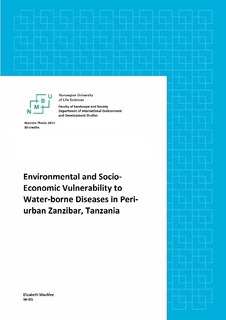| dc.description.abstract | Cities around the world are growing rapidly, giving rise to sprawling peri-urban areas in their surroundings. In coastal East Africa, residents of peri-urban areas find themselves frequently exposed to water-borne infectious diseases when untreated wastewater contaminates drinking water supplies. These areas often lack infrastructure for water, sanitation, and waste management, and due to their position outside municipal boundaries it can be unclear whose responsibility it is to provide services to their residents.
Zanzibar, Tanzania has experienced this problem, and it will likely grow, as between sixty and seventy percent of residents of Zanzibar Town are currently living in unplanned or unauthorised settlements where the population is expected to double in less than twenty years (Revolutionary Government of Zanzibar, 2013; National Bureau of Statistics, 2014). This thesis aimed to examine differences in vulnerability between members of the population of peri-urban Zanzibar Town and the factors that put them at risk of exposure to hazardous bacteria and pathogens. It asks the question, in a densely populated settlement that may appear close to homogeneous at first glance, what makes some people more likely to suffer from water-borne diseases than others?
A combined approach including both water quality testing and qualitative interviews was used to analyse contributions of social, economic, institutional, and environmental factors in determining vulnerability of individuals and groups. Root causes of vulnerability were theorised using a combination of field data and a review of pertinent literature, and this was considered in tandem with observed variations in likely exposure to hazards. Selected study sites were the areas surrounding two wells in the neighbourhoods of Tomondo Mshelishelini and Kijito Upele. The quantity of faecal coliform and E. coli in some of the drinking water wells was quite high, indicating elevated exposure risk for many households. However, within a small spatial area, strategies used by households to prevent disease and clean water, and level of dependence on individual resources, varied greatly. These differences stem from a combination of environmental and socio-economic characteristics and also perception and awareness of impacts of using well water for household needs.
In terms of preventing illness and mitigating exposure to pathogens, from the perspectives of interview subjects (both households and institutions) the responsibility seemed to lie mainly with individuals and households, rather than the government. Personal strategies such as handwashing and treatment of drinking-water were highly emphasized. This perception places the burden of adapting to hazardous conditions on vulnerable members of the community, rather than on government and institutional actors with far greater access to resources. To sustainably reduce disastrous impacts of diarrhoeal disease in peri-urban areas, the government of Zanzibar will need to accept a greater portion of the responsibility for providing safe and sufficient drinking water to all of its citizens. | nb_NO |

